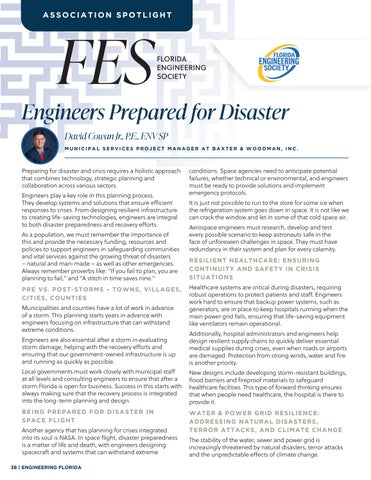ASSOCIATION SPOTLIGHT
FES
FLORIDA ENGINEERING SOCIETY
Engineers Prepared for Disaster David Cowan Jr., P.E., ENV SP MUNICIPAL SERVICES PROJECT MANAGER AT BAXTER & WOODMAN, INC.
Preparing for disaster and crisis requires a holistic approach that combines technology, strategic planning and collaboration across various sectors. Engineers play a key role in this planning process. They develop systems and solutions that ensure efficient responses to crises. From designing resilient infrastructure to creating life-saving technologies, engineers are integral to both disaster preparedness and recovery efforts. As a population, we must remember the importance of this and provide the necessary funding, resources and policies to support engineers in safeguarding communities and vital services against the growing threat of disasters – natural and man-made – as well as other emergencies. Always remember proverbs like: "If you fail to plan, you are planning to fail," and "A stitch in time saves nine." PRE VS. POST-STORMS – TOWNS, VILLAGES, CITIES, COUNTIES Municipalities and counties have a lot of work in advance of a storm. This planning starts years in advance with engineers focusing on infrastructure that can withstand extreme conditions.
conditions. Space agencies need to anticipate potential failures, whether technical or environmental, and engineers must be ready to provide solutions and implement emergency protocols. It is just not possible to run to the store for some ice when the refrigeration system goes down in space. It is not like we can crack the window and let in some of that cold space air. Aerospace engineers must research, develop and test every possible scenario to keep astronauts safe in the face of unforeseen challenges in space. They must have redundancy in their system and plan for every calamity. RESILIENT HEALTHCARE: ENSURING CONTINUITY AND SAFETY IN CRISIS SITUATIONS Healthcare systems are critical during disasters, requiring robust operations to protect patients and staff. Engineers work hard to ensure that backup power systems, such as generators, are in place to keep hospitals running when the main power grid fails, ensuring that life-saving equipment like ventilators remain operational.
Engineers are also essential after a storm in evaluating storm damage, helping with the recovery efforts and ensuring that our government-owned infrastructure is up and running as quickly as possible.
Additionally, hospital administrators and engineers help design resilient supply chains to quickly deliver essential medical supplies during crises, even when roads or airports are damaged. Protection from strong winds, water and fire is another priority.
Local governments must work closely with municipal staff at all levels and consulting engineers to ensure that after a storm Florida is open for business. Success in this starts with always making sure that the recovery process is integrated into the long-term planning and design.
New designs include developing storm-resistant buildings, flood barriers and fireproof materials to safeguard healthcare facilities. This type of forward thinking ensures that when people need healthcare, the hospital is there to provide it.
BEING PREPARED FOR DISASTER IN SPACE FLIGHT
WATER & POWER GRID RESILIENCE: ADDRESSING NATURAL DISASTERS, TERROR ATTACKS, AND CLIMATE CHANGE
Another agency that has planning for crises integrated into its soul is NASA. In space flight, disaster preparedness is a matter of life and death, with engineers designing spacecraft and systems that can withstand extreme 38 | ENGINEERING FLORIDA
The stability of the water, sewer and power grid is increasingly threatened by natural disasters, terror attacks and the unpredictable effects of climate change.













